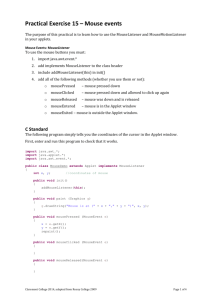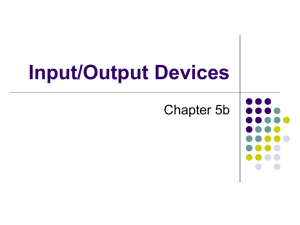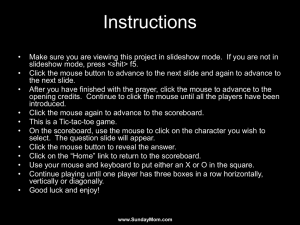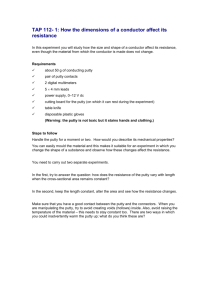Slides - Micromouse USA
advertisement
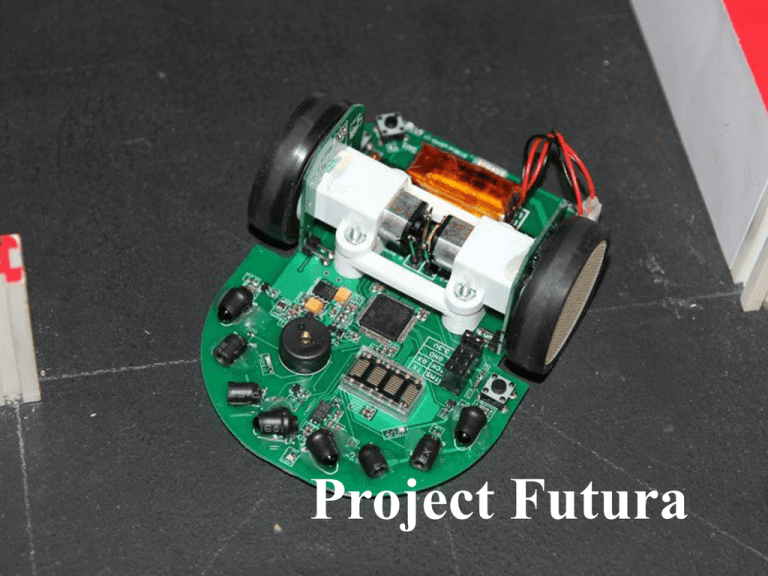
Project Futura Introduction • To help relatively experienced student to learn advanced knowledge of Micromouse • Kit Mouse that capable to make advance movement, such as curve turn and acceleration were made as teach tools • High resolution encoder is the key. • You can apply the what you’ve learned to a working mouse without struggling with potential hardware problem. • You need to design your own mouse for competition Specs Width 75mm Length 100mm height 38mm weight 75g w/ battery wheel 3D printed wheel and mount + mini-z tires (MZT302-20) STM32F405RGT6(168Mhz with internal RC) Processor Motor/Enc Pololu 1:10 gear motor oder HP/AS5304 Encoder Gear ratio 1:10 battery 120mah 25C 2s1p Motor Driver Sensor ZXMHC3F381N8+TC4427 (H-bridge + level shifter) TEFT4300+SFH4545 X 4 Gyro LY3200 User Interface 2 buttons + 11 LEDs + dot matrix display Demo http://www.youtube.com/watch?v=YJhf3xfEgZY How it’s made? Design PCB Solder and prepare all parts/components/testing tools Finish Assembling and do tests to Make sure everything is working Pack them into containers Ready to use for future We spent lots of efforts to make these mouse, play it carefully since they will be used repeatly in the future Lecture 1 Keil IDE • We will be using the Keil IDE to write our code and program the mouse • Step 1: Install the file mdk460.exe • Step 2: Install the st-link_v2_usbdriver • Step 3: Open the file FuturaProject/project/micromouse_test.uvproj with Keil uVision4 Adding a new file to Keil • Step 1: Create the file in either user_Libraries/src (.c files) or user_Libraries/inc (.h files) • Double click on the group user_Libraries_src or user_Libraries_inc in the “Project” pane and select your file Downloading your code to the mouse • Connect the three mouse pins, TMS, TCK, and GND, to the ST-link programmer pins, IO, CLK and GND respectively • In Keil uVision, compile your code by pressing F7. Then click Flash->Download. Sensors • void readSensor() – Reads each sensor and places the results in the global variables: LFSensor, RFSensor, DLSensor, and DRSensor. – This should be called in your systick handler Gyro • void readGyro() – Similar to readSensor() – Sets the variables aSpeed (your mouse’s angular speed) and angle (the current angle of your mouse Volt Meter • void readVolMeter() – Sets the variable voltage – Always make sure your batteries are well charged, especially when using the small batteries Encoders • int32_t getLeftEncCount() & int32_t getRightEncCount() – Returns the current encoder count – 3520 encoder counts per revolution User Interface • Buzzer – void shortBeep(int duration, int freq) • duration – milliseconds • freq – Hz (example 8000) • Matrix display – void displayMatrix(const char* s) • s – 4 character (max) string – See others in matrixDisplay.h • LEDs – LED1_ON, LED2_ON … LED11_ON – LED1_OFF, LED2_OFF … LED11_OFF Delay • void delay_ms(u32 nTime) – nTime – milliseconds Interrupts • void systick() – A 1 millisecond timed interrupt – It is a function that runs every millisecond • void button1_interrupt() & void button2_interrupt() – These functions are run when a button is pressed Motors • void setLeftPwm(int32_t speed) & void setRightPwm(int32_t speed) – speed – A value ranging from -999 through 999, representing the duty cycle of the pwm for the motor. printf • Used to print debugging information • Example: – printf(“Left front sensor: %d\r\n”, LFSensor); • See more information here: http://www.cplusplus.com/reference/cstdio/p rintf/ PuTTY • PuTTY is a desktop application that can be used to communicate with the mouse • Download the windows version here: http://the.earth.li/~sgtatham/putty/latest/x86/putty.e xe • Set connection type to “Serial” • Under “Serial line” type “COMX” where X is your COM port number – You can find the COM port in Windows Device Manager • In the “Serial” tab, set “Flow control” to “None” • Default options should be fine for everything else PuTTY • Connect the FTDI board pins TX, RX, and GND to the RX, TX, and GND pins on the mouse • TX connects with RX • RX connects with TX • You can now communicate with your mouse using printf and PuTTY




